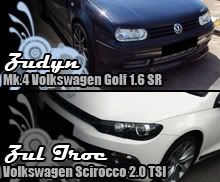-------
The Problem
More exhaust backpressure generally means less horsepower, and a stock catalytic converter is often the greatest source of backpressure in an exhaust system. So it's no wonder the catalytic is often tossed in favor of an eBay "test pipe" when a performance-minded owner starts itching for a little more power. But there are a few downsides to de-catting a car - the big one being that it's illegal.
Hell bent on wrangling every last horsepower out of their steeds, power mongers often run sans-converter on the street; risking tickets, huge fines or even impoundment of their vehicles. But just how much power are they gaining, and is it really worth the risk? If the thought of surrendering your car to the local towing yard keeps you from yanking your converter, there still may be a way to make more power and not break the law.
Aftermarket catalytic converter manufacturers claim their products can reduce backpressure, helping to free up exhaust flow and make more power. They may have fancy CFM flow graphs and other fancy data to back those claims, but can these kitties really flow better than the OEM pieces? And, how do they compare to the good ol' test pipe, in terms of horsepower?
To answer these questions, we took a lightly-modded 1999 Honda Civic SI and did four back-to-back dyno pulls: one with the stock cat, one with a test-pipe, and two pulls with OBD II approved aftermarket high-flow cats. Read on, and see with your own eyes how powerful you can become by killing your cat.
The Test
Breathing through an aftermarket intake, header and cat-back exhaust system, our Civic mule put down a respectable 147hp and 105 lb-ft to the front wheels on K&N Engineering's dyno. Not too shabby, considering the car was still huffing through the stock OEM catalytic converter. Eager to see what we could gain by uncorking the exhaust, we bolted on the first aftermarket cats.
Aftermarket high-flow cats come with two different types of guts, metallic and ceramic. The ceramic type is less expensive to manufacture and will melt and fail at lower temperatures - not ideal for high performance applications. The metallic honeycombs can withstand the higher temperatures and richer air-fuel mixtures but are more expensive to make and subsequently cost more. But cost isn't the only factor to consider if you find yourself replacing the cat.
It's important to ensure that you have the correct type of converter for your application. If your car is OBD I compliant, you can use any EPA or CARB approved OBD I converter. If your car is OBD II compliant, your cat must be OBD II approved. As a general rule, any car 1996 or newer is OBD II and any car 1995 or older is OBD I. However, some cars were OBD II compliant as early as 1994, so double-check the underhood emissions sticker. The difference between OBD I and OBD II cats is bigger than you might think.
OBD II cats are required to remove about 90 percent of emissions, while the OBD I cats are only required to remove 70 percent. So, put an OBD I cat on an OBD II car and you might fail your emissions testing.

(The prettiest test subject of the day, this Magnaflow ceramic-core catalytic converter came dressed in this shiny stainless-steel jacket. And it has the bite to back up its visual bark, netting our Civic an additional 4hp over the stocker. While able to withstand less heat than the metallic cat, it's less expensive and may suffice for some naturally aspirated engines that run relatively lean AFRs.)

(This is your brain on drugs. OK, it's not. This is what happens when you give a cat too much to eat. Really. In normal operation, a cat burns anything that doesn't get burned by the engine. If a car is running excessively rich, all that unburned fuel leaving the engine ignites inside the cat and literally melts the cat down. This cat has been fed a heavy diet of raw fuel and, as you can see, has melted into a worthless pile of crap.)

(This Magnaflow unit is the least restrictive cat you can legally have on your catalyist-equipted vehicle. With a less restrictive core than the ceramic unit and the ability to withstand richer AFRs, a metallic core cat is the ideal candidate for a high-performance street car.)
After removing the OEM cat, we welded and bolted up an OBD II Magnaflow ceramic-core catalytic converter in place of the stock one. With the Magnaflow cat installed, the Honda turned the rollers to the tune of 150hp and 107 lb-ft to the wheels. The ceramic-core cat netted us an additional 3hp and 2 lb-ft to the front wheels. Obviously, this cat really can flow more than stock.
Next up was the metallic core Magnaflow OBD II cat. Because metallic cats can take more abuse and richer AFRs (and generally flow more), these are often the choice of the performance-minded tuner. After much cursing and a bit of charred flesh, we put the fancy metallic-core cat onto the Civic. Apparently, the metallic core unit does indeed flow slightly better than the ceramic unit. But when we say slight, we mean slight. The metallic core cat netted us a 1hp gain (to 151hp) and no increase in torque over the ceramic core. So, unless you are running a rich AFR (like in a boosted application) the extra cost of the metallic core might not be worth it. However, if you are running a rich mixture, the metallic cat is still your best bet.
With the testing of all three cats out of the way, it was time to unplug the exhaust and let her rip without that pesky brick in the exhaust. No matter how you cut it, a cat is a restriction and costs power, right? With the moment of truth at hand, we bolted in our test pipe - eliminating the cat entirely. On our final pull we stood eagerly by the dyno's monitor, waiting to see the results. Wait ... here it comes ... 152hp and 108 lb-ft - a gain of one measly horsepower and one lb-ft of torque at the cost of breaking the law.
The Lowdown
Now that we've armed you with the facts, you should be ready to make the correct decision should you need to replace your cat. Whether or not you choose to run a cat is between you and Johnny Law. But when you consider the potential gains versus the costs, it hardly seems worth risking getting caught. With a difference of only 1hp between a straight pipe and a 49-state LEGAL cat, it seems foolish to flaunt the law and pollute the air that we all breathe. Hell, if you are only looking for those kinds of gains, just loose 10 pounds -that alone will make your car faster than adding 1 measly HP.
The 5hp gained from losing the factory cat for the metallic one is substantial. If the engine were to later receive more extensive mods, the benefits would probably be even greater. What it all boils down to is that a good aftermarket high-flow cat can indeed flow better than a stock unit, and almost as well as a straight pipe. When you can have all the benefits of removing the cat without the risk of getting busted, it's kind of like having your cake and eating it too.
A Caveat
Before you go off all willy-nilly and replace your cat, there are a few things you should understand first. Contrary to popular belief, not all cats are created equally. The stock factory cats usually do the best job of cleaning up the exhaust, but often at the cost of high backpressure. Aftermarket cat flow and ability to pass emissions testing can be iffy because quality varies greatly. In an effort to save money, some manufacturers cut corners and don't include enough of the agents that actually catalyze and create the heat to burn up the pollutants. Install one of these cats and you might not pass smog. This is why it's important to pick one that is CARB or EPA compliant. These cats have been independently tested and should pass an emissions test.












nice posting....i like it...it is really helpful to all...
ReplyDeleteBathmate